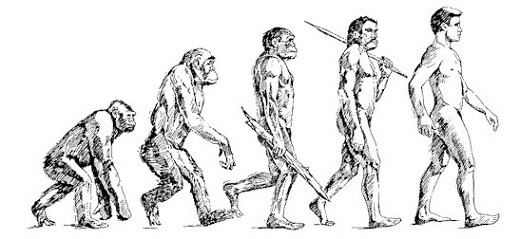This article is taken from the proceedings of the symposium ‘The Two Shall Become One’ held in Rome in September 2015, jointly sponsored by Human Life International and the Kolbe Center for the Study of Creation.
by John M. Wynne
Introduction
Depictions of human evolution may be the most recognized of all Darwinian “icons,” as most people have been exposed to images such as those in Figure 1 since their youth. As recent fossil finds have transformed this icon into a complex timeline, as in Figure 2, paleoanthropologists continue to insist that the strength of the fossil evidence mandates viewing human evolution as a scientific fact.[1] Even as other Darwinian claims have been increasingly abandoned, the staunch defense of this last icon has continued and intensified.
This paper explains that Darwin’s last icon has now fallen. In other words, a critical review of the fossil record using the information in the scientific literature leads to the conclusion that there is no viable evolutionary sequence leading from a common ancestor with the chimpanzee to modern humans.

Figure 1. A Commonly Seen Icon of Human Evolution
The scientific literature refers to peer reviewed periodicals (e.g., Nature, Science, the Journal of Human Evolution, etc.) where fossil finds are first reported and evaluated. While these periodicals are religiously committed to the “fact” of human evolution, the validity of each claimed transitional form is openly debated therein, often with information that is screened from high school and college biology textbooks. Since there are so many claimed transitional forms, arguments among evolutionists that any particular transitional form is not an ancestor of Homo sapiens does no harm to their underlying faith in human evolution.
This paper repeatedly references the scientific literature to show that evolutionists now question the legitimacy of every claimed transitional form and that, using any reasonable standard, most of these claimed intermediates have been completely discredited. This, in turn, leads to a logical conclusion that evolutionists cannot make for philosophical and professional reasons—that there is also a collective failure of all claimed evolutionary sequences leading to Homo sapiens.
It is relatively easy to see that Darwin’s last pillar of support has now crumbled, provided the reader objectively considers the evidence and reflects on problematic presuppositions that may have been held (perhaps unconsciously) since childhood. These presuppositions can include the view that: 1) empirical science is the exclusive source of truth; that 2) scientists are always objective and aren’t influenced by their worldview (scientists don’t lie); and that 3) truth claims about human origins must be grounded exclusively in the domain of natural science and—no matter how poor the evidence for evolution—cannot involve historical theology (i.e., Special Creation cannot be true). These presuppositions result in the mistaken view that the evolutionist’s a priori decision to construct a wall of naturalism around origins constitutes “good science” rather than a flawed philosophical approach that forbids two very logical conclusions. These conclusions are that: 1) the claims of human evolution are not supported by the fossil record; and 2) to the degree that sound inferences can be drawn, the fossil evidence is most easily reconciled with Special Creation.




